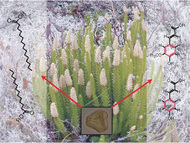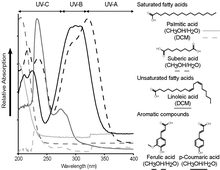Past UV-B radiation

Lycopodium annotinum, Sweden
For my PhD. research I developed and applied a novel biochemical proxy for past UV-B radiation.
By exploiting a natural chemical response in plants to changes in ambient UV-B, their pollen and spores can be used as a passive monitor of UV-B flux through time.
By exploiting a natural chemical response in plants to changes in ambient UV-B, their pollen and spores can be used as a passive monitor of UV-B flux through time.
Sporopollenin chemical composition

UV-Vis absorbency of sporopollenin monomers
A technique called FTIR microspectroscopy was used to study individual spores and pollen grains, and to interrogate the chemical information they contained. By tracking changes in the amount of phenolic groups within the walls of the spores/pollen, it is possible to build up an idea of how much UV-B the parent plant of those spores/pollen grains was exposed to.
The annual reproduction cycle of plants lends itself to the potential of generating a high-resolution time-scale of changes in UV-B as fresh spores/pollen will be produced each year, recording yearly changes within their chemical make-up.
The annual reproduction cycle of plants lends itself to the potential of generating a high-resolution time-scale of changes in UV-B as fresh spores/pollen will be produced each year, recording yearly changes within their chemical make-up.
